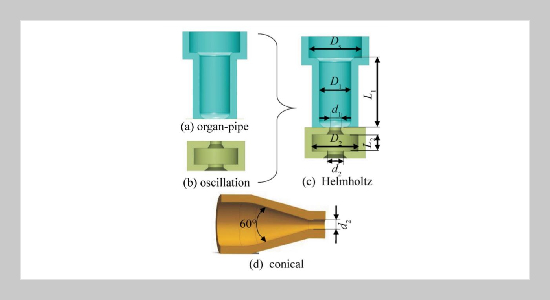REFERENCES
- [1] Yang, F. C., S. W Shiah, and T. Y Heh, et al. (2008) Study of numerical simulation applying to the design of an orifice with high-velocity waterjet, Tamkang Journal of Science and Engineering 11(2), 145�154. doi: 10.6643/DCNH.2001.01.02
- [2] Wang, R., Y. Du, and H. Ni (2011) Hydrodynamic analysis of suck-in pulsed jet in well drilling, Journal of Hydrodynamics 23(1), 34�41. doi: 10.1016/S10016058(10)60085-6
- [3] Zelenak, M., J. Foldyna, and J. Scucka, et al. (2015) Visualisation and measurement of high-speed pulsating and continuous water jets, Measurement 72, 1�8. doi: 10.1016/j.measurement.2015.04.022
- [4] Liu, S., X. Liu, and J. Chen, et al. (2015) Rock breaking performance of a pick assisted by high-pressure water jet under different configuration modes, Chinese Journal of Mechanical Engineering 28(3), 607�617. doi: 10.3901/CJME.2015.0305.023
- [5] Ayed, Y., C. Robert, and G. Germain, et al. (2016) Development of a numerical model for the understanding of the chip formation in high-pressure water-jet assisted machining, Finite Elements in Analysis & Design 108, 1�8. doi: 10.1016/j.finel.2015.09.003
- [6] Zhang, Z., G. Meng, and A. Wang (2018) Numerical simulation of scale removal from mine drainage pipe by water jet, Journal of Applied Science and Engineering 21(2), 145�154. doi: 10.6180/jase.201806_ 21(2).0001
- [7] Lai, S., and Z. Liao (2013) The theory and experimental study of the self-excited oscillation pulsed jet nozzle (pipeline pulsed flow generator), Natural Resources 4(5), 395�403. doi: 10.4236/nr.2013.45049
- [8] Song, X., G. Li, J. Yuan, et al. (2010) Mechanisms and field test of solution mining by self-resonating cavitating water jets, Petroleum Science 7(3), 385�389. doi: 10.1007/s12182-010-0082-0
- [9] Hu, D., X. Li, and C. Tang, et al. (2014) Analytical and experimental investigations of the pulsed air-water jet, Journal of Fluids & Structures 54, 88�102. doi: 10. 1016/j.jfluidstructs.2014.10.010
- [10] Rockwell, D., and E. Naudascher (1978) Review-selfsustainingoscillationsofflowpastcavities, AsmeTransactions Journal of Fluids Engineering 100(2), 152� 165. doi: 10.1115/1.3448624
- [11] Zhang, F., H. Liu, J. Xu, et al. (2013) Experimental investigation on noise of cavitation nozzle and its chaotic behaviour, Chinese Journal of Mechanical Engineering 26(4), 758�762. doi: 10.3901/CJME.2013.04. 758
- [12] Fang, Z. L., Y. Kang, X. C. Wang, et al. (2016) Numerical investigation of cavity diameter ratio influence on helmholtz oscillation waterjet, Journal of Zhejiang University (Engineering Science) 50(11), 2100�2106.
- [13] Liu, W., Y. Kang, M. Zhang, et al. (2017) Self-sustained oscillation and cavitation characteristics of a jet in a helmholtz resonator, International Journal of Heat & Fluid Flow 68, 158�172. doi: 10.1016/j. ijheatfluidflow.2017.10.004
- [14] Li, D., Y. Kang, X. Ding, et al. (2017) Effects of feeding pipe diameter on the performance of a jet-driven helmholtz oscillator generating pulsed waterjets, Journal of Mechanical Science &Technology 31(3), 1203� 1212. doi: 10.1007/s12206-017-0219-9
- [15] Wang, P., and F. Ma (2009) Vibration analysis experiment of self-resonating cavitating water jet, Journal of Mechanical Engineering 45(10), 89�95. doi: 10.3901/ JME.2009.10.089
- [16] Li, D., X. Li, Y. Kang, et al. (2015) Experimental investigation on the influence of internal surface roughness of organ pipe nozzle on the characteristics of high pressure jet, Journal of Mechanical Engineering 51(17), 169�176. doi: 10.3901/JME.2015.17.169
- [17] Li, D., Y. Kang, X. Wang, et al. (2016) Effects of nozzle inner surface roughness on the cavitation erosion characteristics of high speed submerged jets, Experimental Thermal & Fluid Science 74, 444�452. doi: 10.1016/j.expthermflusci.2016.01.009
- [18] Yang, Y., J. Zhang, and S. Nie (2013) Energy Loss of nozzles in water jet system,Journal of Mechanical Engineering 49(2), 139�145. doi: 10.3901/JME.2013.02. 139
- [19] Fang, Z. L., Y. Kang, X. C. Wang, et al. (2014) Numerical and experimental investigation on flow field characteristics of organ pipe nozzle, IOP Conference Series: Earth and Environmental Science 22(5), 052020. doi: 10.1088/1755-1315/22/5/052020
- [20] Li, D., Y. Kang, X. Ding, et al. (2016) Effects of area discontinuity at nozzle inlet on the characteristics of self-resonating cavitating waterjet, Chinese Journal of Mechanical Engineering 29(4), 813�824. doi: 10. 3901/CJME.2016.0426.060
- [21] Li, G., and Z. Shen (1992) Design principle of organpipe cavitating jet nozzles, Journal of the University of Petroleum China 16(5), 35�39.
- [22] Chahine, G. L., V. E. J. Jr, W. T. Lindenmuth, et al. (1985) The use of self-resonating cavitating water jets for underwater sound generation, Journal of the Acoustical Society of America 77(77), 113�126. doi: 10. 1121/1.392274
- [23] Xu, P. P., J. Liu, F. Ma, et al. (2015) Analysis methods for flow pressure signals in oscillation cavity of a selfresonating jet nozzle, Journal of Vibration & Shock 34(17), 180�184 and 198.
- [24] Han, J., J. Liu, H. Wang, et al. (2015) Anew detection method of fluid pulsation inside the oscillation cavity of a self-resonating water jet nozzle, Chinese Journal of Engineering 37(9), 1191�1197.
- [25] Ma, F., T. Cai, J. Liu, et al. (2016) Experimental study of self-resonating water jet frequency characteristics, Journal of Mechanical Engineering 52(14), 182�187. doi: 10.3901/JME.2016.14.182
















